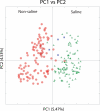Global patterns in bacterial diversity
- PMID: 17592124
- PMCID: PMC2040916
- DOI: 10.1073/pnas.0611525104
Global patterns in bacterial diversity
Abstract
Microbes are difficult to culture. Consequently, the primary source of information about a fundamental evolutionary topic, life's diversity, is the environmental distribution of gene sequences. We report the most comprehensive analysis of the environmental distribution of bacteria to date, based on 21,752 16S rRNA sequences compiled from 111 studies of diverse physical environments. We clustered the samples based on similarities in the phylogenetic lineages that they contain and found that, surprisingly, the major environmental determinant of microbial community composition is salinity rather than extremes of temperature, pH, or other physical and chemical factors represented in our samples. We find that sediments are more phylogenetically diverse than any other environment type. Surprisingly, soil, which has high species-level diversity, has below-average phylogenetic diversity. This work provides a framework for understanding the impact of environmental factors on bacterial evolution and for the direction of future sequencing efforts to discover new lineages.
Conflict of interest statement
The authors declare no conflict of interest.
Figures



References
Publication types
MeSH terms
Substances
Grants and funding
LinkOut - more resources
Full Text Sources
Other Literature Sources

